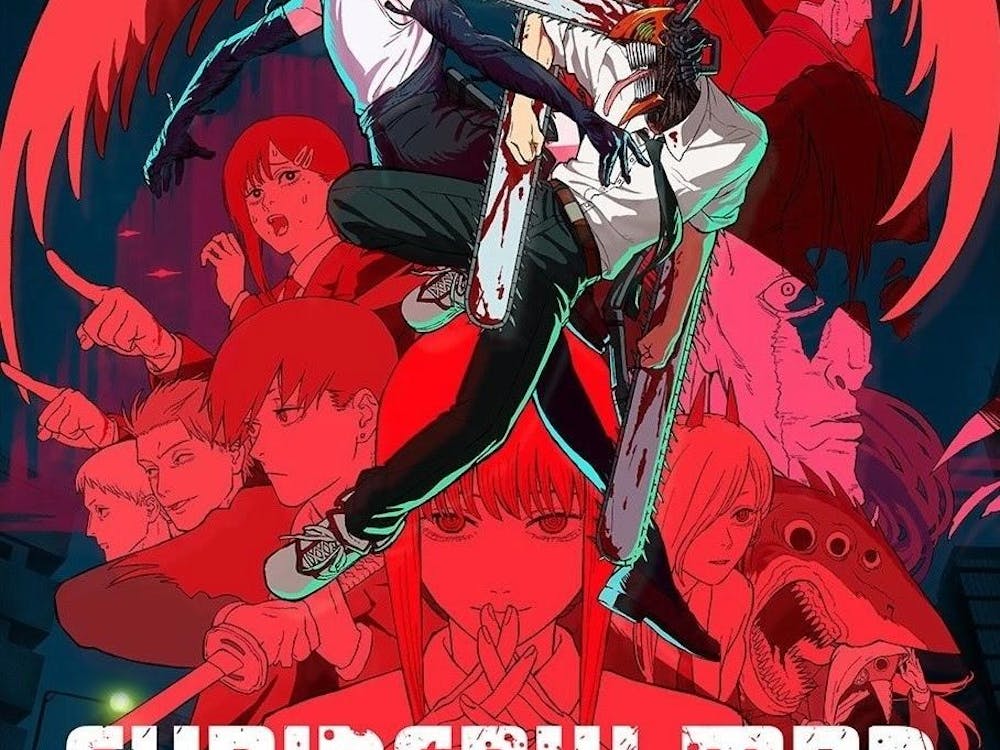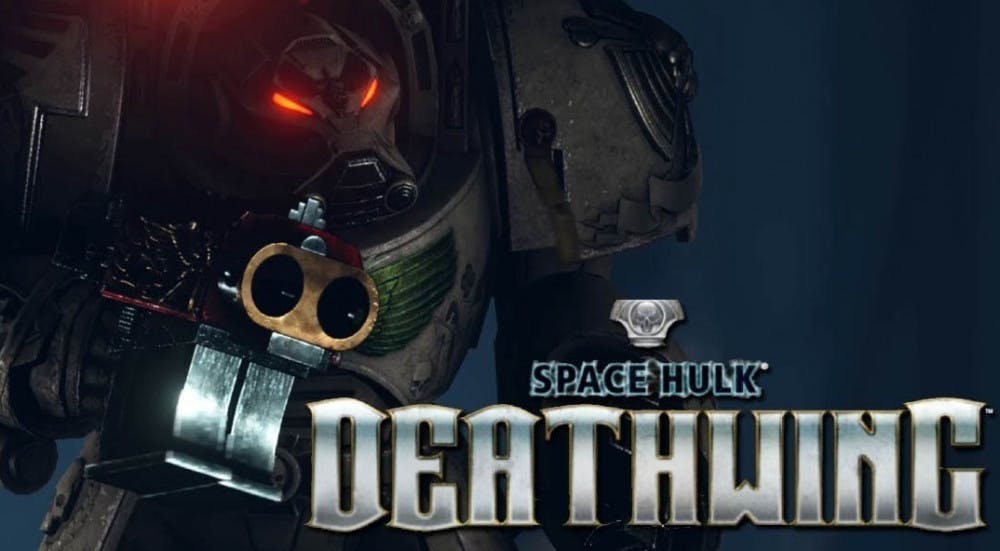by Aidan Kearney Disclaimer: This review was conducted on a PC with a GTX 780i, i7, 16GBs of RAM This review is focused on the single-player aspect of the game. Space Hulk: Deathwing thrusts the player deep into the heart of a massive spacecraft with a simple task: purge the xenos. With permission from Warhammer 40k owners Games Workshop, French developer Streum-on Studios created this Tactical First-Person Shooter based on a 1989 board game of the same name. Players can expect gameplay similar to Star Wars: Republic Commando thanks to its squad command element. Deathwing’s setting is the forever-grimdark yet over-the-top Warhammer 40,000 table-top series. In the 41st Millennia, there is only war. Humanity’s Imperium of Man is pitted against mutants, eldritch abominations, and in the case of Deathwing: Tyranids, an insectoid alien species hell-bent on consuming everything in its path. Deathwing offers a short but sweet single-player campaign, with multiplayer co-op play available after. Combat is absolute abundance in both, but with some kinks in the armor.
Combatting the alien threat
Think “special forces wizard” and the ability to teleport into an enemy instantly destroying them...The Imperium of Man assigns the player to lead a squad of Terminators to scour the Space Hulk, a derelict space craft filled with xenos. Terminators are massive, heavily-armored super-soldiers loyal to their military company and armed to the teeth. The player leads a three-man squad against thousands of Tyranids. From chapter to chapter, players can expect an ambush at any moment wandering the halls of the massive ship, responding in turn with commanding their squad. Commands are issued to the squad through a quick menu, with the ability to move, defend an area, or attack a specific target. Utilizing the command quick menu is absolutely essential to ensuring the two NPC squad members don’t die during any intense battles.
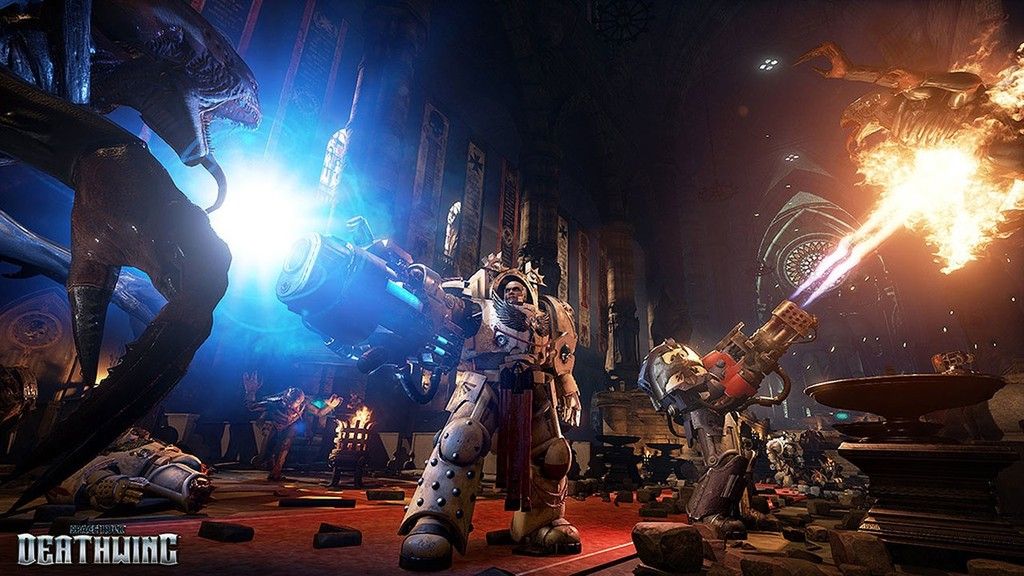 As the squad leader, the player takes control of the Librarian: a Terminator capable of using psychic powers. Think “special forces wizard” and the ability to teleport into an enemy instantly destroying them. If setting aliens on fire isn’t enough, the player can turn the environment against the enemy. Turrets are located throughout each mission that enable the player to quickly hack them through a menu, and firing on what’s in their rage. Be warned, as failing to directly control a turret can lead to the turret opening fire upon the squad and the player. It can be pretty easy to locate turrets thanks to a minimap and radar, alongside the map menu which displays your objectives
While exploring the ship the player will encounter aliens of all shapes and sizes. Smaller strains of Tyranids can emerge from virtually any opening in the Space Hulk, meaning the player has to constantly be on their guard. Swarms are indicated by an obvious roar heard throughout the environment, leading to dozens of Tyranids filling the screen. At close range, melee weapons easily cleave through enemies, causing them to explode into bloody chunks and ragdoll throughout the environment. A great deal of coordination is needed to deal with much more advanced Tyranids found in later chapters. Despite being in such heavy armor, the player is not indestructible, and taking even a couple hits from the greater enemies can be a fatal flaw.
As the squad leader, the player takes control of the Librarian: a Terminator capable of using psychic powers. Think “special forces wizard” and the ability to teleport into an enemy instantly destroying them. If setting aliens on fire isn’t enough, the player can turn the environment against the enemy. Turrets are located throughout each mission that enable the player to quickly hack them through a menu, and firing on what’s in their rage. Be warned, as failing to directly control a turret can lead to the turret opening fire upon the squad and the player. It can be pretty easy to locate turrets thanks to a minimap and radar, alongside the map menu which displays your objectives
While exploring the ship the player will encounter aliens of all shapes and sizes. Smaller strains of Tyranids can emerge from virtually any opening in the Space Hulk, meaning the player has to constantly be on their guard. Swarms are indicated by an obvious roar heard throughout the environment, leading to dozens of Tyranids filling the screen. At close range, melee weapons easily cleave through enemies, causing them to explode into bloody chunks and ragdoll throughout the environment. A great deal of coordination is needed to deal with much more advanced Tyranids found in later chapters. Despite being in such heavy armor, the player is not indestructible, and taking even a couple hits from the greater enemies can be a fatal flaw.
Heavy Metal
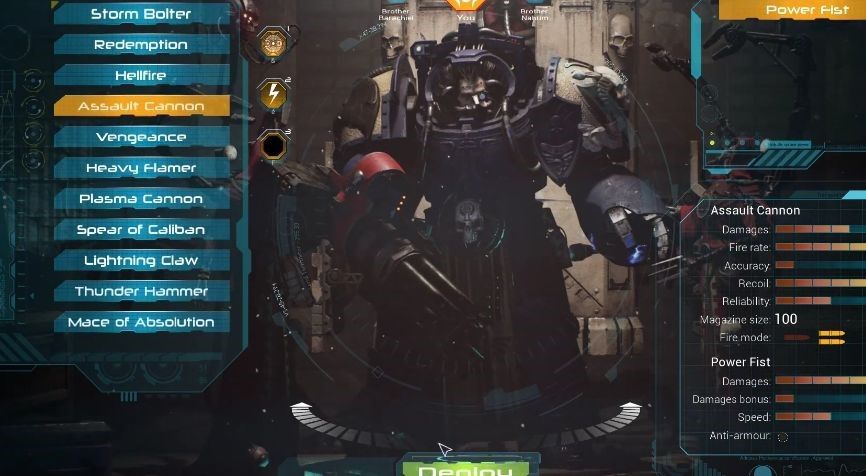 The player is in an incredibly bulky suit of armor and it feels like it. Every lumbering step makes a satisfying thud. Thankfully the player won’t be walking all the time, as a long sprint is available for traversal throughout the ship. With the heavy armor comes heavy weaponry. A load-out is picked before each game chapter. To start, the player is given a giant electrified gauntlet and a handheld machine gun that shoots miniaturized rockets, tearing apart any Tyranid you come across. Enemy encounters only get more brutal from there, with gatling guns and flamethrowers that provide different gunplay each chapter. From the load-out menu, players can customize their squad members as well, but with fewer options than the player character. Further equipment is granted through upgrading the squad’s section in the skill tree. This skill tree is available for upgrade at the end of each chapter, with points allocated based on how well the player performed in each mission, be it enemies killed, doors hacked or collectables found.
The player is in an incredibly bulky suit of armor and it feels like it. Every lumbering step makes a satisfying thud. Thankfully the player won’t be walking all the time, as a long sprint is available for traversal throughout the ship. With the heavy armor comes heavy weaponry. A load-out is picked before each game chapter. To start, the player is given a giant electrified gauntlet and a handheld machine gun that shoots miniaturized rockets, tearing apart any Tyranid you come across. Enemy encounters only get more brutal from there, with gatling guns and flamethrowers that provide different gunplay each chapter. From the load-out menu, players can customize their squad members as well, but with fewer options than the player character. Further equipment is granted through upgrading the squad’s section in the skill tree. This skill tree is available for upgrade at the end of each chapter, with points allocated based on how well the player performed in each mission, be it enemies killed, doors hacked or collectables found.
The Belly of the Beast
Moving close to the walls, the player can hear the claws skittering through ventilation shafts and heavy breathing from an invisible Tyranid stalking the squad.In Space Hulk: Deathwing, players navigate both the claustrophobic confines and massive cathedral halls of the eponymous Space Hulk: an amalgamation of ships fused together through chaotic magic and spit out into space through interdimensional travel. In a combination of the new Unreal 4 engine and Streum-On’s level design team, the results are gloriously impressive. Despite much of the game taking place walking through corridors of the ship, very little of it feels repetitive. Each chapter takes the player to a different part of the Space Hulk that contains noticeable differences in design than the last one. One moment the player will be defending a massive cooling unit hidden behind an ornately carved door, the next they’ll be exterminating a hive of Tyranids with walls covered organic growths and the floor crawling with tentacles. Going to each area feels like a reward for exploring the Space Hulk. However, players should not expect quick chapters. Each
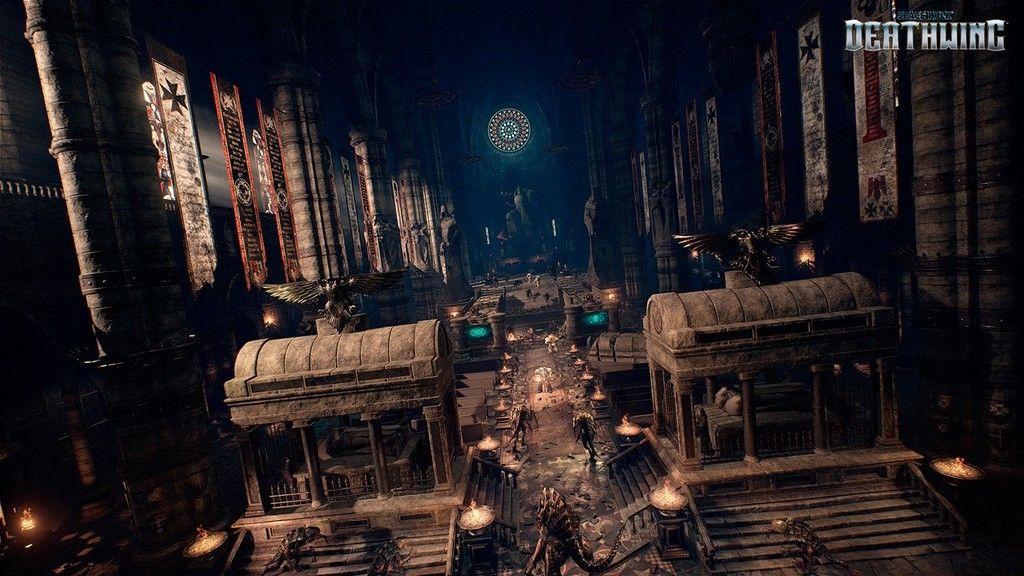 level is far from linear, as chapters often involve exploring entirely different ships, rather than just different sections of one ship. Taking the time to explore every area of a level can easily take 30-45 minutes per chapter.
After completing it, I would highly recommend playing Space Hulk: Deathwing with headphones. Streum-On’s sound team went all out in emulating exploration of a massive spacecraft. There was a very specific design choice in not including background music within the game. Thanks to the silence, every single sound the player makes is amplified. Every step and every firefight stands out. Each weapon sounds distinctive. In exploring the ship, the lack of music adds a tactical element to the game. The player will easily hear the enemies before they see them. Moving close to the walls, the player can hear the claws skittering through ventilation shafts and heavy breathing from an invisible Tyranid stalking the squad. Progressing through each chapter wouldn’t be nearly as enjoyable if the sound design weren’t as good as it is.
level is far from linear, as chapters often involve exploring entirely different ships, rather than just different sections of one ship. Taking the time to explore every area of a level can easily take 30-45 minutes per chapter.
After completing it, I would highly recommend playing Space Hulk: Deathwing with headphones. Streum-On’s sound team went all out in emulating exploration of a massive spacecraft. There was a very specific design choice in not including background music within the game. Thanks to the silence, every single sound the player makes is amplified. Every step and every firefight stands out. Each weapon sounds distinctive. In exploring the ship, the lack of music adds a tactical element to the game. The player will easily hear the enemies before they see them. Moving close to the walls, the player can hear the claws skittering through ventilation shafts and heavy breathing from an invisible Tyranid stalking the squad. Progressing through each chapter wouldn’t be nearly as enjoyable if the sound design weren’t as good as it is.






